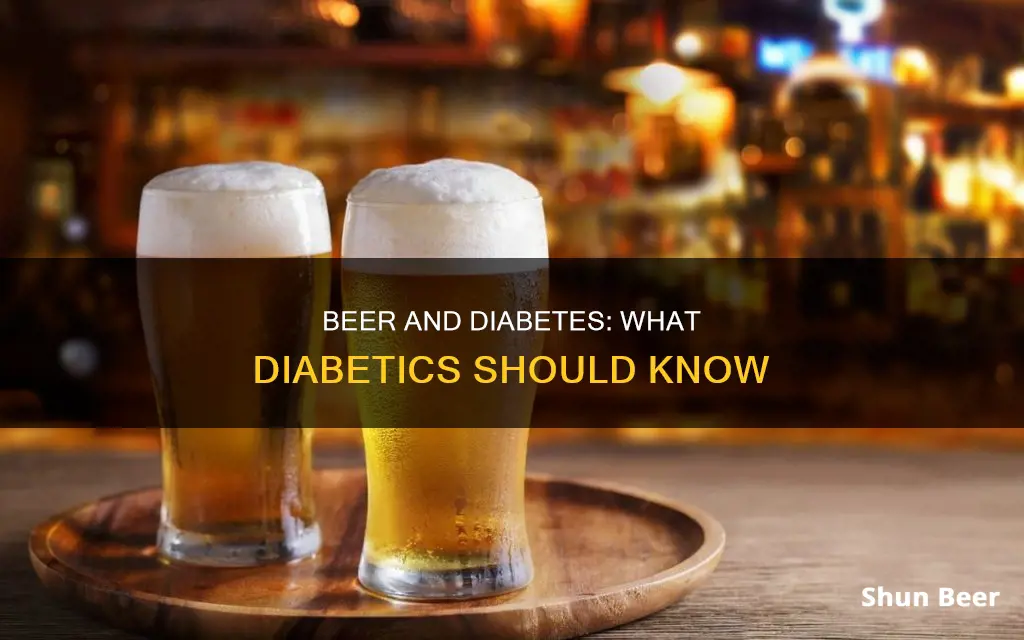
Drinking alcohol is a common pastime, but for people with diabetes, it can be a tricky subject. Alcohol can interfere with blood sugar levels, and for those taking insulin or other medications, this can lead to dangerously low blood sugar. Beer, being a significant source of carbohydrates, can impact blood sugar and contribute to weight gain over time. So, what does this mean for diabetics who want to enjoy a cold one? Are there any risks or benefits associated with drinking beer if you have diabetes? This article will explore the effects of beer consumption on diabetes and provide guidelines for safe drinking.
What You'll Learn

Alcohol and hypoglycemia
Alcohol and hypoglycaemia are linked, and the combination can be unsafe, especially for people with diabetes.
The liver is responsible for keeping blood sugar within typical limits. It stores and releases sugar as needed, acting as a reservoir for carbohydrates. However, the liver also detoxes the body, breaking down toxins like alcohol. The problem arises when the liver has to choose between balancing blood sugar and detoxification. If it prioritises metabolising alcohol, blood sugar levels can drop, leading to hypoglycaemia.
Consuming alcohol on an empty stomach or when blood sugars are already low increases the likelihood of hypoglycaemia. Symptoms of hypoglycaemia include lightheadedness, dizziness, confusion, and, in more extreme cases, loss of consciousness. These symptoms can be challenging to distinguish from drunkenness.
For people with diabetes, alcohol consumption can cause low or high blood sugar and affect diabetes medications. Alcohol competes with the liver's ability to produce glucose, and drinking can slow down carb metabolism, potentially leading to low blood sugar (hypoglycaemia). This risk is heightened when drinking without eating and can last for hours after the last drink.
To prevent hypoglycaemia, it is recommended not to drink on an empty stomach and to monitor blood sugar levels regularly while drinking and for up to 24 hours after. It is also important to be aware of how much alcohol is considered safe. Generally, it is recommended that women have no more than one drink per day and men no more than two. One drink is defined as 12 ounces of beer, 5 ounces of wine, or a 1.5-ounce shot of liquor.
Additionally, it is advised to drink slowly, mix liquor with water or diet drinks, carry a source of sugar like glucose tablets, and avoid exercising after drinking, as it increases the risk of low blood sugar.
Beer and Cefdinir: Is It Safe to Mix?
You may want to see also

Diabetes medication and alcohol
If you have diabetes, drinking alcohol may be safe for you, but it is important to be aware of how alcohol can affect your blood sugar levels and interact with your medication.
Alcohol and Blood Sugar
Alcohol can cause your blood sugar levels to rise or fall, depending on how much you drink and whether you have eaten recently. The liver is responsible for clearing alcohol from the body and releasing glucose into the bloodstream. When you drink alcohol, your liver has to work to remove it from your blood instead of regulating blood sugar. This can lead to low blood sugar (hypoglycemia) and may continue up to 24 hours after drinking.
Alcohol and Diabetes Medication
Alcohol can interact with diabetes medications, including insulin, sulfonylureas, and metformin. Combining the blood-sugar-lowering effects of these medications with alcohol can lead to dangerously low blood sugar levels, known as hypoglycemia or "insulin shock," which is a medical emergency. If you are taking diabetes medication, it is important to talk to your doctor about how alcohol may affect you and whether it is safe to drink.
Precautions for Drinking with Diabetes
If you choose to drink alcohol, it is important to take the following precautions:
- Don't drink on an empty stomach. Eat a meal or snack containing carbohydrates before or while drinking alcohol.
- Avoid drinking if your blood sugar is already low.
- Stay hydrated by drinking plenty of water.
- Monitor your blood sugar levels regularly before, during, and after drinking, and up to 24 hours afterward.
- Be aware of the symptoms of hypoglycemia, such as dizziness, drowsiness, confusion, or difficulty walking, as they can be similar to the symptoms of being drunk.
- Let the people around you know the signs to look out for and how to help if your blood sugar drops.
- Avoid binge drinking or drinking more than the recommended limit.
Recommended Drinking Limits
The recommended drinking limits for adults are no more than one drink per day for women and no more than two drinks per day for men. One drink is equivalent to 12 fluid ounces (360 ml) of regular beer (5% alcohol), 5 fluid ounces (150 ml) of wine (12% alcohol), or 1.5 fluid ounces (45 ml) of 80-proof distilled spirits (40% alcohol).
Beer and Wine: Mixing, Matching, and Drinking Safely
You may want to see also

Alcohol's calorie content
Alcoholic drinks contain calories that can quickly add up, with a couple of drinks potentially adding 500 or more calories to your daily intake. Most alcoholic drinks have little to no nutritional value.
The calorie content of alcoholic drinks varies depending on the type of drink, the amount of alcohol, and the presence of added sugars or mixers. For example, cocktails mixed with soda, juice, cream, or ice cream can be especially high in calories.
Beer is typically higher in carbohydrates than other alcoholic drinks like wine or liquor, and it can also be high in calories. The calorie content of beer depends on the type, with "light" beers generally having fewer calories than craft beers. A 12-ounce can of beer typically contains around 13 grams of carbohydrates and 150-200 calories.
Wine also varies in calorie content depending on the type and alcohol content. A standard glass of wine can contain up to 158 calories, while a pint of stronger lager can contain up to 222 calories. Fortified wines tend to have a higher ABV and, therefore, more calories.
Distilled spirits or hard liquors, such as whiskey, brandy, gin, rum, vodka, and whiskey, typically have the highest ABV and can range from 100 to 120 calories per shot. These drinks contain very few to no carbohydrates.
When it comes to weight management and health, it's important to be mindful of the calorie content of alcoholic beverages and to consume them in moderation.
Beer Temperature: Re-Chilling After Warming, Safe?
You may want to see also

Alcohol's effect on blood sugar
Effect on Blood Sugar Levels
Alcohol can cause a person's blood sugar levels to rise or fall. When you drink alcohol, your liver is busy breaking it down, which interferes with its ability to release glucose into the bloodstream. This can lead to a drop in blood sugar levels, especially if you drink on an empty stomach. The risk of low blood sugar is higher for people with diabetes, especially those taking insulin or medications that stimulate insulin production. This can lead to hypoglycemia, which can be dangerous.
Recommended Intake
Moderate alcohol consumption, defined as up to one drink per day for women and up to two drinks per day for men, is generally considered safe for people with diabetes. However, it's important to note that "one drink" refers to specific serving sizes, such as 12 fluid ounces of regular beer, 5 fluid ounces of wine, or 1.5 fluid ounces of distilled spirits. Excessive alcohol consumption can increase the risk of chronic diseases and interfere with diabetes medications.
Type of Alcoholic Beverage
The choice of alcoholic beverage also matters. Beer and sweet wine contain carbohydrates and may raise blood sugar levels. Low-carb beers and wines, such as dry wines or brut Champagne, are better options for people with diabetes. Distilled spirits like gin, rum, vodka, or whiskey contain zero grams of carbohydrates per serving, but they can still lead to hypoglycemia, especially when consumed on an empty stomach.
Food Consumption
It is recommended to consume alcohol with food to prevent drinking on an empty stomach. Eating a meal or snack containing carbohydrates while drinking can help maintain blood sugar levels. This is especially important for people with diabetes to reduce the risk of hypoglycemia.
Calorie and Weight Considerations
Alcoholic beverages often contain a significant number of calories, which can make weight loss more difficult. Additionally, alcohol stimulates appetite and can affect judgement, leading to overeating and poor food choices.
Individual Considerations
The effects of alcohol on blood sugar can vary from person to person. It is always recommended to consult with a doctor or healthcare provider to determine if drinking alcohol is safe and to get guidelines for alcohol consumption. They can provide personalised advice based on an individual's diabetes management, medication, and overall health condition.
Pregnancy and Dark Beer: Is It Safe to Drink?
You may want to see also

Safe drinking guidelines
If you have diabetes, it is important to know how to drink alcohol safely. Here are some guidelines to help you drink responsibly and maintain your blood sugar levels:
- Moderation is key: Limit your alcohol consumption to no more than one drink per day for women and up to two drinks per day for men. Excessive drinking can lead to higher blood glucose and A1C levels.
- Avoid drinking on an empty stomach: Alcohol can cause hypoglycemia (low blood sugar) by interfering with your liver's ability to release glucose. Eat before drinking and have food handy while you sip.
- Monitor your blood sugar: Keep track of your blood sugar levels before, during, and after drinking. Hypoglycemia can occur up to 24 hours after your last drink.
- Stay hydrated: Drink plenty of water along with your alcoholic beverage to stay hydrated and help regulate your blood sugar.
- Choose low-carb options: Opt for \"light\" beers, red or white wine, distilled spirits, or low-carb cocktails. Beer is typically higher in carbs than wine or liquor.
- Pace yourself: If you're drinking over several hours, such as at a sporting event, limit yourself to no more than one drink per hour and no more than three to four drinks total for the day.
- Avoid high-sugar mixers: When drinking spirits, use diet or sugar-free mixers to avoid adding extra sugar to your drink.
- Be mindful of medication interactions: If you are taking insulin or other diabetes medications, consult your doctor or healthcare team. Alcohol can interact with these medications and increase the risk of hypoglycemia.
- Know the symptoms of hypoglycemia: The symptoms of low blood sugar, such as dizziness, drowsiness, and confusion, can be similar to the symptoms of being drunk. Educate your friends about these signs so they can help you if needed.
- Carry identification: Always wear medical ID jewellery or carry identification that states you have diabetes. This will ensure you receive proper assistance in an emergency.
Beer Drinking in Tennessee Grocery Stores
You may want to see also
Frequently asked questions
Yes, it is generally safe for diabetics to drink beer, but in moderation and while being mindful of how it affects their blood sugar levels. It is recommended to not drink on an empty stomach and to keep checking blood sugar levels while drinking and up to 24 hours after.
Beer is a significant source of carbohydrates, so it can impact blood sugar. Beer can also be high in calories, which may contribute to weight gain over time.
Symptoms of low blood sugar, or hypoglycemia, can include feeling dizzy or lightheaded, and in more extreme cases, loss of consciousness. These symptoms are similar to those of being drunk, so it is important to be aware of the difference.
The general alcohol consumption recommendation for both diabetics and non-diabetics is the same: no more than one drink a day for women and up to two drinks a day for men. It is important to pace yourself and not drink more than one drink per hour.
Low-carb beers have fewer calories and carbs than regular beers, so they may be a better option for diabetics. Additionally, distilled spirits or hard liquors contain very few to no carbs, but they can lead to very low blood sugar levels, especially if consumed on an empty stomach.







